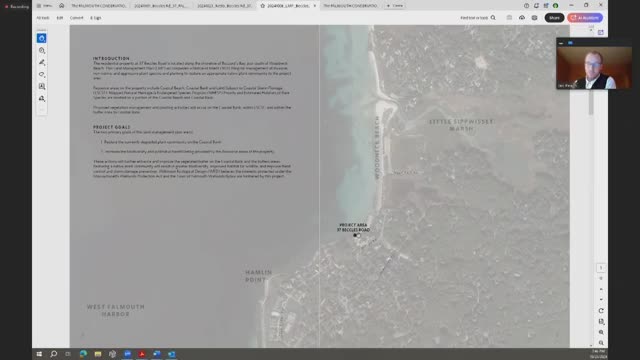Community project plans ecological restoration to enhance pollinator habitats
October 23, 2024 | Town of Falmouth, Barnstable County, Massachusetts
This article was created by AI summarizing key points discussed. AI makes mistakes, so for full details and context, please refer to the video of the full meeting. Please report any errors so we can fix them. Report an error »

During the Falmouth Conservation Commission meeting on October 23, 2024, a significant proposal for voluntary ecological restoration was presented, focusing on a coastal bank heavily invaded by non-native plant species. The project aims to restore approximately 5,600 square feet of this area, with two primary goals: enhancing community engagement with the coastal environment and improving biodiversity, particularly for pollinators.
The restoration plan highlights the current state of the property, which is dominated by invasive species such as porcelain berry, multiflora rose, and Asiatic bittersweet, with about 90% of the area affected. However, the project also identified pockets of native plants, including jewelweed and high bush blueberry, which provide a unique opportunity to inform the restoration efforts. These native species indicate potential areas for successful planting and biodiversity enhancement.
To achieve the project goals, a comprehensive planting plan has been developed, proposing the introduction of 32 native shrub species along the coastal bank. Additionally, the plan includes the integration of 15 flowering herbaceous species into an existing mitigation area, which will enhance the ecological value of the site. The selection of these plants is strategic, aiming to provide a continuous supply of nectar and pollen throughout the growing season, thereby supporting a diverse range of pollinators.
This restoration initiative not only seeks to combat the spread of invasive species but also aims to foster a healthier ecosystem that benefits both wildlife and the local community. The discussions at the meeting underscored the importance of ecological restoration in maintaining biodiversity and enhancing the natural beauty of Falmouth's coastal areas. As the project moves forward, it will be crucial to monitor its progress and assess the long-term impacts on the local environment.
The restoration plan highlights the current state of the property, which is dominated by invasive species such as porcelain berry, multiflora rose, and Asiatic bittersweet, with about 90% of the area affected. However, the project also identified pockets of native plants, including jewelweed and high bush blueberry, which provide a unique opportunity to inform the restoration efforts. These native species indicate potential areas for successful planting and biodiversity enhancement.
To achieve the project goals, a comprehensive planting plan has been developed, proposing the introduction of 32 native shrub species along the coastal bank. Additionally, the plan includes the integration of 15 flowering herbaceous species into an existing mitigation area, which will enhance the ecological value of the site. The selection of these plants is strategic, aiming to provide a continuous supply of nectar and pollen throughout the growing season, thereby supporting a diverse range of pollinators.
This restoration initiative not only seeks to combat the spread of invasive species but also aims to foster a healthier ecosystem that benefits both wildlife and the local community. The discussions at the meeting underscored the importance of ecological restoration in maintaining biodiversity and enhancing the natural beauty of Falmouth's coastal areas. As the project moves forward, it will be crucial to monitor its progress and assess the long-term impacts on the local environment.
View full meeting
This article is based on a recent meeting—watch the full video and explore the complete transcript for deeper insights into the discussion.
View full meeting
